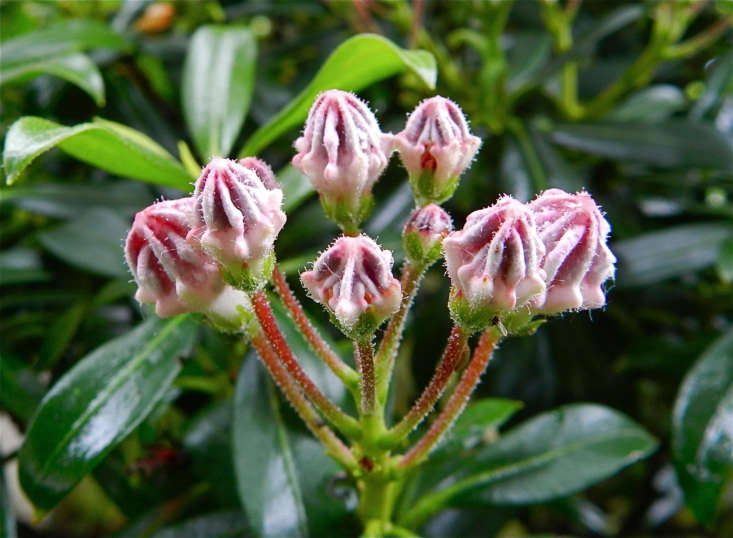Mountain laurel, Kalmia latifolia: “Calico Bush”
The first time I remember seeing mountain laurel blooming in the wild was in a most unlikely habitat, the parking lot of Mount Vernon, George Washington’s historic estate in Virginia high above the Potomac River. In contrast to the formal, meticulously manicured flower and vegetable gardens inside the historic site, the shrubs bordering the asphalt were a ragtag bunch. The mountain laurel was growing on the edge of a scruffy little woods among some other weedy residents. I was able to identify it by its clusters of very distinctive, small, cup-shaped polygon flowers. The plants were clearly left to grow on their own and the mountain laurel was rather leggy with sparse leaves. However, even in such challenging circumstances, these plants in bloom were eye-catching and appealing.
Is mountain laurel the right shrub for your garden? Read on.

That Kalmia latifolia, which is a native evergreen plant, should be growing on the grounds of an American historic site is totally appropriate since its presence in the colonies was first recorded as early as 1624. It is the state flower of both Connecticut and Pennsylvania and is a member of a small genus (only seven species) in the Ericaceae family. That makes mountain laurel a relative of other woody shrubs such as blueberries and cranberries as well as rhododendrons and azaleas, with which it is often combined in woodland gardens.
Mountain laurel is found in the eastern United States from New England south to Louisiana and the Florida panhandle, where it is found in forest margins, mountain slopes, and cool meadows. In spring it can be seen in bloom along the Blue Ridge Parkway in North Carolina and in the pitch pine forests of upstate New York where it grows abundantly. It is also well suited to the coastal Pacific Northwest, thriving in the cool, moist climate.

Cheat Sheet
- If visitors to your garden include pets or children, be advised that all parts of Kalmia latifolia are poisonous if ingested.
- This plant attracts hummingbirds, butterflies, and bees (although their honey will be toxic and should be avoided).
- Protect the delicate fibrous mountain laurel roots with a two-to-six-inch layer of mulch.
- This plant cannot tolerate salt so avoid placing it near the ocean or close to roads in cold climates where salt is used to melt snow and ice.
Keep It Alive
- Plant mountain laurel in well-drained, cool, moist, acidic soil in USDA zones 5-9.
- Good drainage is essential to avoid rot. If drainage is an issue in your garden, consider planting this shrub in a raised bed.
- Mountain laurel will grow in deep shade to full sun but is happiest in moderate to partial shade. In full shade it will produce fewer flowers while too-bright sun can cause scorching of the leaves.
- Deadheading spent blooms will increase the next year’s flower production.
While mountain laurel can exceed 30 feet in the wild, in cultivation it rarely grows taller than 10 feet and seldom requires pruning. However, if your plant is outgrowing its spot in your garden, you can prune it just after flowering down almost to ground level. Kalmia latifolia is a slow grower but tolerates hard pruning very well and will grow again into a large shrub in several years time.

The nickname “calico bush” alludes to the tiny dots and lines on mountain laurel flowers, which are said to resemble the prints on calico fabric. In addition to their distinctive appearance, the flowers have an unusual way of dispensing pollen. The stamens are arched, their tips held under pressure by the rim at the top of the flower petals. When a bee or other pollinator lands on the flower, the weight of the insect releases the stamen, which flings its load of pollen up like a tiny catapult.

While the flowers, which bloom in late spring, are its most distinctive feature, mountain laurel stays green all year and provides uninterrupted interest with prominent buds that precede the flowers and brown seedpods which appear in late summer and remain on the plant throughout the winter. In addition, as the plant ages, its branches can become gnarly with attractive peeling bark. The flower colors of native mountain laurel species are mainly limited to pink and white but in recent years many hybrids have appeared, widening the color choices.

Most prominent among hybridizers is Richard A. Jaynes the founder of the Broken Arrow Nursery in Hamden, Connecticut. On the nursery’s website are listed 21 varieties of Kalmia latifolia that are all the company’s own introductions. They include “Firecracker,” a small plant with bright red buds that mature into white flowers; “Minuet” which has deep maroon flowers with white markings; and “Peppermint” with pale pink flowers striped in deep red. Jaynes is also the author of an exhaustive volume Kalmia: Mountain Laurel and Related Species, required reading for the true mountain laurel connoisseur.
Get ideas on how to plant, grow, and care for more of our favorite shrubs and hedges with our Shrubs: A Field Guide. To see how mature shrubs will look in your garden, read:
- Landscape Ideas: Blazing Color with Red Twig Dogwood, 5 Ways
- Azaleas 101: A Field Guide to Planting, Care & Design
- 10 Garden Ideas to Steal from Instagrammers
- Winter Enchantment: 9 Best Witch Hazels for a Luminous Garden
- 10 Best Garden Design Ideas for 2018













Have a Question or Comment About This Post?
Join the conversation (1)